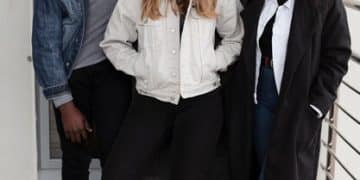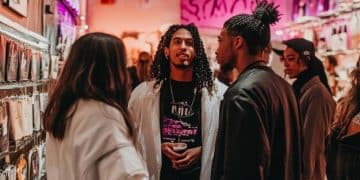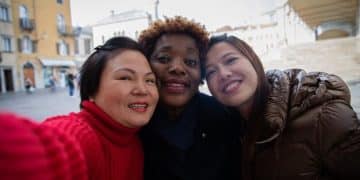Gen Z’s Influence on US Fashion Trends: Hot or Not in 2025?
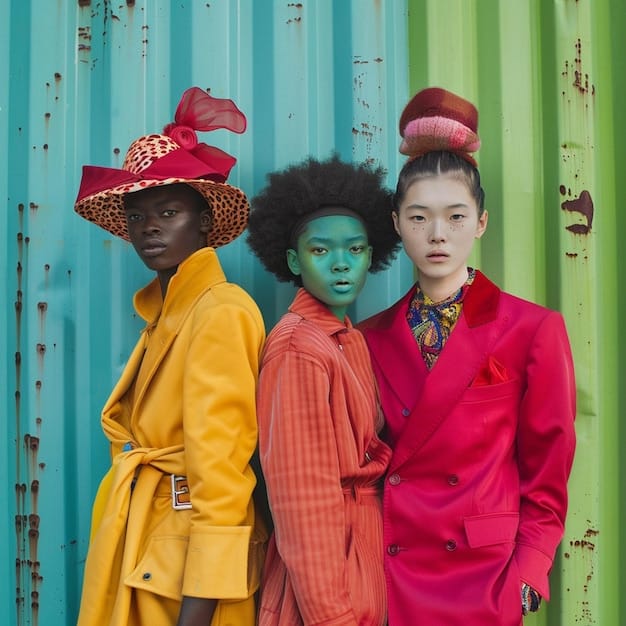
Gen Z’s impact reshapes US fashion, moving towards sustainable, expressive, and digital-first styles, prioritizing personal identity and comfort over traditional luxury brands in 2025’s evolving landscape.
Understanding the pulse of youth culture is crucial for predicting the fashion landscape. The Gen Z’s Influence on US Fashion Trends: What’s Hot and What’s Not in 2025? defines the sartorial direction, prioritizing individuality, sustainability, and digital integration. This generation isn’t just following trends; they’re actively creating them, making their mark on everything from streetwear to high fashion with a distinct voice and aesthetic.
The rise of authentic self-expression
Gen Z, often characterized by its digital native status and a strong sense of social awareness, approaches fashion with a deeply personal perspective. For this generation, clothing is far more than mere attire; it’s a powerful tool for broadcasting identity, values, and individual narrative. This shift signifies a departure from previous generations’ focus on brand loyalty or conformity, moving instead towards a celebration of authenticity and uniqueness prevalent in the Gen Z’s Influence on US Fashion Trends: What’s Hot and What’s Not in 2025?.
This emphasis on self-expression permeates every aspect of their aesthetic, from thrift store finds to bespoke creations. They aren’t afraid to experiment, blend disparate styles, or challenge established norms, creating a fluid and ever-evolving fashion lexicon.
Beyond brand names: the value of individuality
While previous generations might have coveted designer labels for status, Gen Z often seeks out pieces that resonate with their personal story or ethical stances, rather than simply those with high price tags. This doesn’t mean they shy away from luxury, but rather that their definition of luxury is redefined through the lens of individual connection and impact.
- Personal curation: Building wardrobes from a mix of vintage, independent brands, and upcycled items.
- Storytelling through style: Each outfit choice communicates a facet of their identity, beliefs, or mood.
- Rejection of conformity: A deliberate move away from homogenous “it” items towards distinctive pieces.
In essence, Gen Z’s influence has democratized fashion, making it less about what’s dictated by runways and more about what genuinely speaks to the individual. Their approach prioritizes comfort, versatility, and the ability of clothing to adapt to their dynamic lives and evolving identities. This quest for authentic self-expression is a cornerstone of how Gen Z is shaping US fashion trends.
Sustainability and ethical consumption: driving forces
Environmental and social consciousness are not just buzzwords for Gen Z; they are fundamental principles that guide their purchasing decisions, especially within the fashion industry. This generation has grown up acutely aware of climate change, labor exploitation, and waste, leading them to demand more from brands than ever before. Their influence is profoundly reshaping the conversation around ethical consumption and production within the Gen Z’s Influence on US Fashion Trends: What’s Hot and What’s Not in 2025?.
This demographic isn’t merely observing the problems; they are actively seeking solutions and choosing brands that align with their values. This often translates to a preference for secondhand, upcycled, and ethically produced garments, signaling a significant shift in consumer behavior.
The rise of secondhand and vintage markets
Thrifting, once a niche activity, has become a mainstream fashion choice for Gen Z. Platforms like Depop, Poshmark, and Vestiaire Collective thrive because they cater directly to this generation’s desire for unique, affordable, and sustainable clothing. Buying secondhand not only reduces textile waste but also allows for the discovery of distinctive pieces with character. This trend highlights a conscious effort to move away from fast fashion’s disposable model.
- Circular fashion economy: Embracing buying, selling, and swapping clothes to extend their lifecycle.
- Environmental impact reduction: Lowering carbon footprint and conserving resources associated with new production.
- Unique style discovery: Finding one-of-a-kind items that stand out from mass-produced apparel.
Beyond thrifting, Gen Z actively scrutinizes brand practices, from supply chain transparency to material sourcing. They support brands that use recycled fabrics, invest in ethical labor practices, and are transparent about their environmental policies. This unwavering commitment to sustainability means that brands failing to adapt will likely find themselves increasingly irrelevant. The collective purchasing power of Gen Z is therefore a potent force driving the fashion industry towards a more responsible future, where ethical considerations are as important as aesthetic appeal.
Digital fashion and virtual influence: Meta-trends of 2025
As digital natives, Gen Z seamlessly integrates their online and offline lives, and fashion is no exception. The metaverse, virtual reality, and gaming platforms are no longer just places for entertainment but have evolved into significant arenas for self-expression and style. This digital frontier is a burgeoning space for the Gen Z’s Influence on US Fashion Trends: What’s Hot and What’s Not in 2025?, blurring the lines between real and virtual wardrobes.
In 2025, digital fashion is set to transcend novelty, becoming an integral part of how Gen Z defines and showcases their aesthetic. This includes everything from purchasing virtual skins for avatars to experimenting with augmented reality (AR) filters that let them “try on” clothes.
Avatars as style icons: The new frontier of self-expression
The concept of an avatar goes beyond a simple digital representation; it’s an extension of one’s identity. Gen Z spends considerable time and resources curating their digital personas, including their outfits. Brands are taking note, collaborating with gaming platforms and developing virtual collections that cater to this burgeoning market. Fashion houses are launching digital-only lines, proving that desirability can exist without physical form.
- NFT fashion: Owning unique digital garments as non-fungible tokens, often with real-world counterparts.
- Gaming collaborations: Brands partnering with popular games to design exclusive virtual attire for players.
- AR try-on experiences: Utilizing augmented reality to visualize how clothing looks on them before purchasing.
This digital influence doesn’t merely stay within virtual realms. What gains traction in the metaverse can often inspire real-world trends, creating a feedback loop between digital and physical fashion. The ease of experimentation and the freedom from traditional limitations in digital spaces allow Gen Z to explore bolder, more imaginative styles that eventually trickle down into everyday wear. Hence, understanding digital fashion is key to grasping the full scope of Gen Z’s ongoing impact on fashion trends.
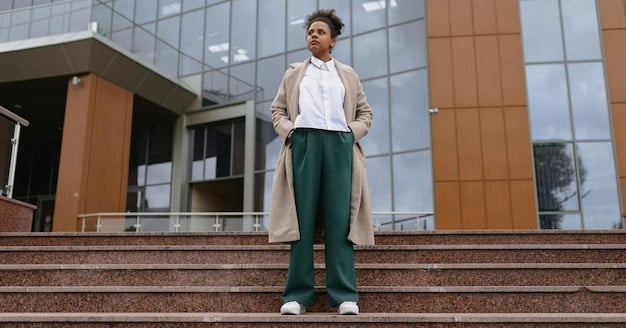
Comfort meets style: The athleisure evolution
The pandemic accelerated many trends, and one of the most enduring for Gen Z is the unparalleled demand for comfort. However, this comfort is not at the expense of style; rather, it has led to an innovative fusion of athletic wear and leisure wear, giving rise to sophisticated athleisure. This evolution is a significant factor in shaping the Gen Z’s Influence on US Fashion Trends: What’s Hot and What’s Not in 2025?, reflecting a lifestyle that values practicality without sacrificing aesthetic appeal.
Gen Z’s daily routines often blend work, study, social, and fitness activities, requiring clothing that is versatile and adaptable. Athleisure perfectly fits this need, offering garments that are stylish enough for a casual outing yet comfortable enough for lounging or light exercise.
From sweatpants to statement pieces: redefining casual wear
The humble sweatpant, once relegated to home use, has undergone a significant transformation. It’s now often paired with structured blazers, sophisticated knitwear, or statement accessories, elevating it to a chic and acceptable item for various occasions. This blending of formal and informal elements is a hallmark of Gen Z’s approach to dressing.
- Elevated basics: Investing in high-quality, comfortable staples that can be mixed and matched.
- Functional fashion: Prioritizing clothing that offers both style and practical utility, like pockets or moisture-wicking fabrics.
- Hybrid wardrobes: Building collections that effortlessly transition from a workout to a coffee shop meeting.
This movement towards comfort-centric styling also emphasizes body positivity and relaxed silhouettes. Oversized fits, relaxed tailoring, and flowing fabrics are preferred over restrictive garments, promoting a sense of ease and freedom. Athleisure, therefore, isn’t just a trend; it’s a reflection of Gen Z’s holistic lifestyle, one that values well-being and authenticity above all else, continuing to solidify its place as a dominant force in contemporary fashion.
Gender fluidity and inclusivity: breaking sartorial norms
Gen Z is a generation that inherently rejects rigid binaries, and this boundary-breaking mindset is profoundly influencing fashion. The concept of “gendered clothing” is increasingly seen as outdated, paving the way for a more fluid, inclusive, and expansive approach to dress. This embrace of gender fluidity is a cornerstone of the Gen Z’s Influence on US Fashion Trends: What’s Hot and What’s Not in 2025?, challenging traditional fashion categories and opening up new avenues for self-expression.
For Gen Z, clothing is simply clothing, devoid of inherent gender associations. They advocate for and actively seek out pieces that can be worn by anyone, regardless of their gender identity, fostering a more accepting and diverse fashion landscape.
Androgynous silhouettes and unisex collections
The market is responding to this demand with an increasing number of brands launching unisex collections that feature androgynous silhouettes, neutral color palettes, and versatile designs. These collections allow individuals to choose clothes based on personal preference and style, rather than being confined by traditional gender expectations. Oversized blazers, wide-leg trousers, and utilitarian jumpsuits are examples of garments that effortlessly cross traditional gender lines.
- Democratization of style: Making fashion accessible and relevant to all gender identities.
- Rejection of stereotypes: Moving past predefined notions of what “men’s” or “women’s” clothing should look like.
- Expressive freedom: Encouraging individuals to wear what makes them feel most authentic and confident.
Beyond clothing, accessories also play a crucial role in this shift. Jewelry, handbags, and footwear are being designed with a more universal appeal, removing the historical gendered marketing. This commitment to inclusivity is not just a passing trend; it’s a fundamental value system for Gen Z who believe in authentic representation and freedom of expression for everyone. Their impact ensures that fashion in 2025 will be more diverse, accepting, and representative of the rich tapestry of human identity than ever before.
The micro-trend cycle: TikTok’s undeniable impact
The speed at which fashion trends emerge and dissipate has dramatically accelerated, largely due to platforms like TikTok. Gen Z, being highly active on these social media channels, is both the originator and consumer of this rapid-fire trend cycle. This constant flux is a defining characteristic of the Gen Z’s Influence on US Fashion Trends: What’s Hot and What’s Not in 2025?, creating a dynamic and often ephemeral fashion landscape.
Unlike previous eras where trends lasted for seasons, micro-trends on TikTok can emerge, peak, and fade within weeks, or even days. This phenomenon requires brands and consumers alike to be constantly agile and responsive.
From “cores” to viral aesthetics: The fleeting nature of style
TikTok is a breeding ground for hyper-specific aesthetic “cores” – think “coastal grandmother,” “cottagecore,” “dark academia,” or “balletcore.” These aesthetics are often highly visual, inspiring users to curate entire wardrobes around a particular mood or theme. While some gain significant traction, many are fleeting, quickly replaced by the next viral sensation.
- Trend acceleration: What once took months to become popular now happens in days.
- Participatory culture: Users don’t just consume trends; they actively create and adapt them.
- Influence of algorithms: Personalized feeds expose users to a diverse range of niche styles, amplifying new trends.
This rapid cycle has implications for both consumers and the industry. For Gen Z, it means constant inspiration and the freedom to experiment with various styles without long-term commitment. For brands, it presents a challenge to remain relevant, requiring a much quicker turnaround from design to market, or a focus on timeless pieces that can transcend these micro-trends. Understanding the power of TikTok algorithms and the participatory nature of its community is essential for anyone looking to navigate the future of fashion influenced by Gen Z.
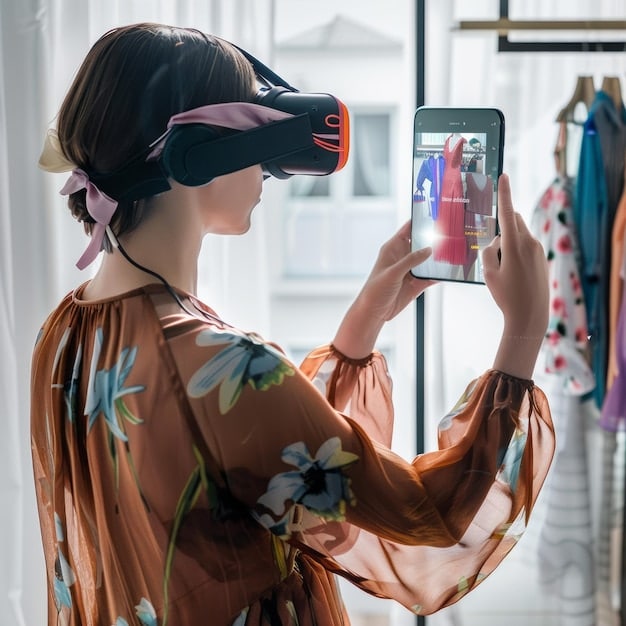
The evolving retail experience: immersive and personalized
Gen Z’s expectations for retail experiences differ significantly from those of previous generations. They seek more than just transactional exchanges; they desire immersive, personalized, and value-driven interactions, both online and in physical stores. This preference for unique and engaging retail forms a crucial part of the Gen Z’s Influence on US Fashion Trends: What’s Hot and What’s Not in 2025?. For brands to capture their attention and loyalty, they must adapt to this new paradigm, blending digital innovation with authentic human connection.
The traditional brick-and-mortar store, if it is to survive, must transform into an experience hub. Similarly, online platforms need to offer more than just a catalog; they must provide intuitive, interactive, and personalized shopping journeys.
Beyond the checkout: community and content
Physical stores are evolving into spaces for community building, workshops, and content creation. Pop-up shops, brand activations, and interactive displays that encourage social sharing are particularly appealing to Gen Z. These spaces offer a chance to connect with a brand’s narrative and values on a deeper level, far beyond simply buying a product.
- Experiential retail: Creating memorable in-store moments that go beyond typical shopping.
- Personalized recommendations: Leveraging AI and data to offer tailored product suggestions.
- Seamless omnichannel journey: Integrating online and offline experiences for a cohesive brand interaction.
Online, Gen Z expects seamless navigation, personalized recommendations, and engaging multimedia content. Live shopping events, virtual try-ons, and direct interaction with influencers or brand representatives through chat bots or social media are all becoming standard expectations. Brands that successfully merge these digital and physical innovations, creating truly holistic and engaging retail experiences, will be the ones that thrive in the era of Gen Z influence. Their demand for authenticity, community, and innovation continues to push the boundaries of how fashion is bought, sold, and experienced.
| Key Trend | Brief Description |
|---|---|
| ✨ Authentic Self-Expression | Prioritizing personal identity and unique style over traditional brand loyalty. |
| ♻️ Sustainability Focus | Strong preference for ethical production, secondhand, and eco-friendly materials. |
| 🎮 Digital Fashion & Influence | Virtual clothing, AR filters, and metaverse styling are trending alongside physical wear. |
| 👚 Gender Fluidity | Breaking traditional gender norms with inclusive, unisex collections and styles. |
Frequently asked questions about Gen Z fashion
Gen Z prioritizes individuality, authenticity, and ethical values over brand loyalty or conformity. They often mix vintage, independent brands, and upcycled items, viewing fashion as a powerful extension of their identity and a way to express their social and environmental consciousness, moving away from a purely trend-driven approach.
Sustainability is a core driver for Gen Z consumers. They actively seek brands with transparent ethical practices, prefer secondhand or upcycled clothing, and are very conscious of product lifecycle. This commitment stems from their deep awareness of environmental and social issues, significantly impacting the demand for eco-friendly fashion.
Digital technology is central to Gen Z fashion. Platforms like TikTok propel micro-trends, while virtual reality, the metaverse, and gaming offer new avenues for style expression through avatars and digital clothing. Augmented reality “try-on” experiences and NFT fashion are also increasingly prevalent, blurring digital and physical fashion lines.
Absolutely. Gender fluidity is a major influence. Gen Z largely rejects traditional gendered clothing, preferring unisex collections and androgynous silhouettes. They choose garments based on personal style and comfort rather than societal expectations, promoting a more inclusive and expressive approach to fashion that resonates with their identity.
Athleisure has deeply evolved from simple gym wear to a sophisticated fusion of comfort and style. Gen Z integrates comfortable pieces like elevated sweatpants with more formal items, creating versatile outfits for various occasions. This trend reflects their dynamic lifestyles and a preference for functional yet fashionable clothing that prioritizes well-being.
Conclusion
The Gen Z’s Influence on US Fashion Trends: What’s Hot and What’s Not in 2025? paints a vivid picture of a generation that is not merely consumers but powerful catalysts for change. Their relentless pursuit of authenticity, unwavering commitment to sustainability, pioneering embrace of digital fashion, and revolutionary approach to gender fluidity are collectively reshaping the industry. They demand more than just clothes; they seek stories, values, and avenues for genuine self-expression. For brands aiming to thrive in this evolving landscape, understanding these core tenets is paramount. The future of fashion, as dictated by Gen Z, is one of individuality, responsibility, innovation, and an ever-present quest for what truly resonates on a personal level.
